Atlatl: A History of the Ancient Spear Thrower
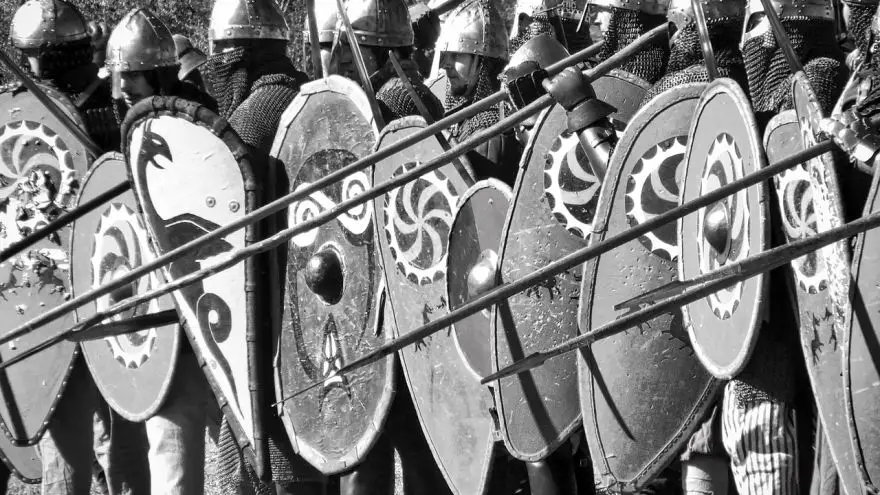 Atlatl: A History of the Ancient Spear Thrower
thegearhunt.com
Atlatl: A History of the Ancient Spear Thrower
thegearhunt.com
If you are unfamiliar with the atlatl, it is an ancient weapon that came before the bow and arrow in many areas of the world. They are one of the first mechanical inventions. It is pronounced atal-atal or at-latal and the word comes from the Aztecs, who still used them when the Spanish encountered them back in the 1500s.
Other words for this device include:
- Woomera or miru, which are the English versions of Australian terms
- Speerschleuder, German
- Propulseur, French
- Estolica, Spanish
- Spear thrower
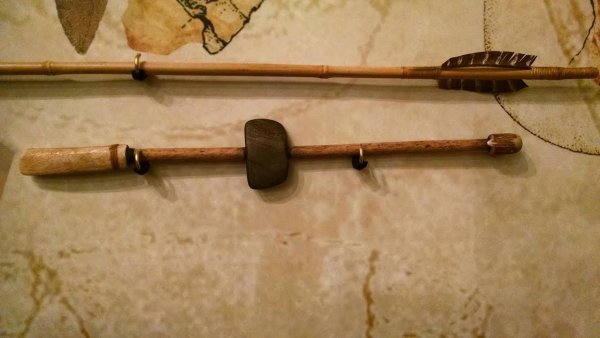 Essentially, the atlatl is a stick that has been equipped with a handle on one of its ends and a socket or hook that will engage a dart or light spear on its other end. The atlatl’s flipping motion will propel a spear much farther and faster than if it was thrown by hand.
Essentially, the atlatl is a stick that has been equipped with a handle on one of its ends and a socket or hook that will engage a dart or light spear on its other end. The atlatl’s flipping motion will propel a spear much farther and faster than if it was thrown by hand.
Most of our ancestors used these tools in the distant past. The only continent that doesn’t have recorded evidence of these being used is Africa. In the Upper Paleolithic period, early modern humans invented spear throwers. These people originated even earlier than those in Africa, so there is the possibility that we just don’t have any evidence yet of any spear throwers in Africa.
The first spear throwers we know about come from some of the European Upper Paleolithic areas in Spain and France. Most of them are from the era known as the Magdalenian period, which was around 15,000 B.C., and we have at least a single example that comes from the even earlier period known as Solutrean. The hook parts that survived were made from reindeer antler or ivory, and the fancier ones are actually quite well-known examples when it comes to art from prehistoric times.
In the Americas, early people used this tool to hunt such Pleistocene Megafauna as mastodons and mammoths as far back as 11,000 B.C. In later periods, a variety of atlatl versions were being used in many different areas of North America. There are quite a few projectile points that have been found in American sites that were used as darts for the atlatl, and these are not arrowheads.
The atlatl began to be replaced by the bow and arrow as early as 1000 B.C., but the atlatl was still used in conjunction with the bow and arrow until modern times in some places, such as the Arctic and Mexico. It is easier to use than a bow and arrow, and you will be able to carry more ammunition for bows than for atlatls, but the dart system and the atlatl do have their advantages. You can use them with only a single hand, which allows your other hand to carry a shield in battles, or even a paddle if you are in a canoe. They throw projectiles that are heavier, which makes it easier to attach a line to them for use in harpooning. They are also not as affected by the conditions being wet.
In more recent eras, these tools have been used by people in the Arctic, South America, New Guinea, and even Australia.
History
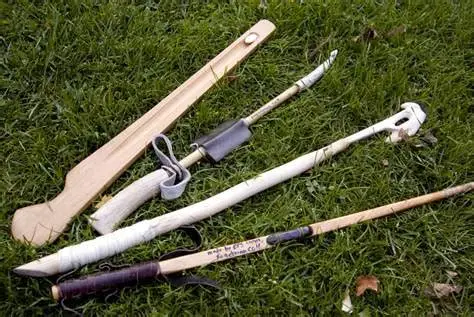 The best and earliest data that is regarding the atlatl has been retrieved from quite a few caves in France. They date back to between 17,000 and 21,000 years ago. The earliest actual atlatl shaft we have found is just a simple hook made from an antler and it dates back to the Solutrean period and was found at the site, Combe Sauniere.
The best and earliest data that is regarding the atlatl has been retrieved from quite a few caves in France. They date back to between 17,000 and 21,000 years ago. The earliest actual atlatl shaft we have found is just a simple hook made from an antler and it dates back to the Solutrean period and was found at the site, Combe Sauniere.
This weapon/tool might have been introduced to the Americas during the mass immigration of peoples who crossed the Bering Land Bridge. Even when the bow and arrow began to be used, the use of the atlatl was widespread when peoples in the Americas first encountered Europeans. There have been complete wooden spear throwers found on a few dry sites in the American west as well as in environments in Washington and Florida that are waterlogged.
The aborigines in Australia and the peoples of New Guinea also used this type of spear thrower. The ones used in Australia were called woomeras.
Aside from practical use as a weapon for hunting, this tool may also have had a few social effects. An anthropologist from Grinnell College, in Iowa, by the name of John Whittaker, has suggested that the atlatl was actually a social type of equalizer because of the fact that using it required skill as opposed to simple power from muscles. Because of this, children and women would also have been able to take part in the hunting. That being said, in more recent societies of Australian aborigines, the spear throwers have been restricted to use only by the males as a custom.
Whittaker also noted that the Aztec used their atlatls with projectiles that were tipped with stone, and these didn’t have the power necessary to penetrate the steel plate armor that was worn by the Spanish, but they were powerful enough to make it through the cotton and leather armor and chain mail that was worn by many of the Spanish soldiers. The Aztecs would begin their battles using the darts from the atlatl and would follow that up with a melee sort of combat during which they used something called the macuahuitl.
Throwing a Spear or Dart with an Atlatl
 There is a throwing motion that is used with an atlatl that is essentially the same motion one would use when they throw a rock or a ball. Mainly, the difference is that when you make the wrist snapping motion at the end of the throw, your wrist will provide a sort of short lever arm, but that identical snap of your wrist when you are using an atlatl gives you a lever that is longer, in essence, adding another joint to your arm.
There is a throwing motion that is used with an atlatl that is essentially the same motion one would use when they throw a rock or a ball. Mainly, the difference is that when you make the wrist snapping motion at the end of the throw, your wrist will provide a sort of short lever arm, but that identical snap of your wrist when you are using an atlatl gives you a lever that is longer, in essence, adding another joint to your arm.
In order to throw a dart or spear using this tool, you will need to hold the atlatl firmly while you set your hook in the hollow notch that is on the end of your dart. Use your thumb and index finger to keep the dart in place, or you can also rest it on the dart rest (forked part) of the atlatl. (Found on more modern ones.) The actual throw can be described as having 4 phases. The motion needs to be comfortable and smooth, just as it would be if you were throwing a snow ball.
Your aiming posture should be balanced and then a throw starts with:
- A single step before
- Your body rotates, and the shoulder and arm will start to move the dart and atlatl
- The wrist will snap in order to give the atlatl the leverage it needs
- Follow through.
Throwing in Detail
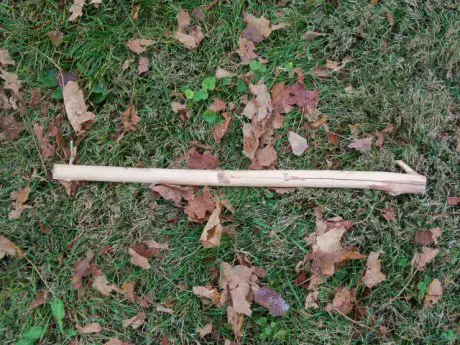 Begin with a standing posture. Your feet should be close together. Put your left foot forward and lean slightly back with the arm holding the atlatl cocked back. Turn your body nearly 90° from your target so that the atlatl can be pointed at it when raised. The dart or spear should be level or just a tad above horizontal, at or just above your eye level (this will depend on the range). Align the dart with your target or attempt to as this is not like being able to sight it down as you would with the barrel of a gun.
Begin with a standing posture. Your feet should be close together. Put your left foot forward and lean slightly back with the arm holding the atlatl cocked back. Turn your body nearly 90° from your target so that the atlatl can be pointed at it when raised. The dart or spear should be level or just a tad above horizontal, at or just above your eye level (this will depend on the range). Align the dart with your target or attempt to as this is not like being able to sight it down as you would with the barrel of a gun.
The throw will visibly begin with a tiny bend of your left knee as you rock fractionally back. Then, bring your left foot forward as if you would be taking a step. This will bring your dart, arm, and body forward. Don’t move your arm or rotate your torso though until you have completed a full step, and your left foot is almost at or flat on the ground.
As you complete your step, your torso should begin to rotate and then your upper arm should begin to flex right at the shoulder. This will bring the atlatl and your hand forward until they are nearly even with the back of your head.
Throughout all of this motion, the actual atlatl should remain at a horizontal position. The flexing of the shoulder seems to be a small one and your wrist should be rotating in order to keep it aimed at your target.
Just before your hand gets to the rear of your head, your forearm and hand should start to rise.
As your hand passes your head, you should snap your wrist vigorously, which will swing the atlatl to a vertical position to fling the dart or spear away. This dart will flex while the point is still aimed at your target, while the actual nock will be raised with the atlatl.
By this time, your arm should be fully extended and straight out. The motion of the wrist seems to essentially be the same as it would be if you were cocking back to throw a ball. The only difference will be that your fingers will stay closed due to you needing to keep ahold of the atlatl. The dart should be high over your head right before it leaves the atlatl.
When you have the atlatl in position vertically, the dart will have recovered from the initial flexing, and should be ready to fly from the spear thrower while it flexes back into the opposite direction.
When the dart leaves the spear thrower, with the atlatl in a vertical position, or just past that position, you should continue the throw and follow through as you would if you were throwing a ball. Lean just a bit forward and swing your arm with the spear thrower down and across your body, with it ending up just outside of your left leg.
Your chin should remain up and your head should be at nearly the same level for the entire throw, keeping your eyes directed toward your target. This is called conscious good form. If you happen to begin with your arm low, bend over, or drop your shoulder, you will miss your target because the spear or dart will go lower than you wanted it to.
Modern Sport
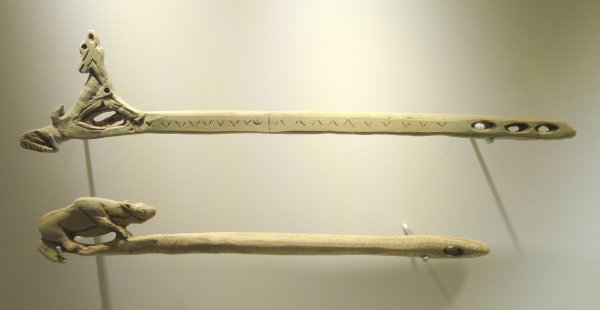 There are quite a few strange ways that ancient technology has survived. The sport of atlatl is just a part of a current trend in recreational interest in what are known as primitive skills. It can be a simple thing to learn how to use this weapon/tool, but becoming an expert at it is difficult.
There are quite a few strange ways that ancient technology has survived. The sport of atlatl is just a part of a current trend in recreational interest in what are known as primitive skills. It can be a simple thing to learn how to use this weapon/tool, but becoming an expert at it is difficult.
It is easy to make atlatls that are both effective and simple. That being said, some of the modern atlatls and even some of the ancient ones are both beautiful and elaborate. There can be a lot of variation among the details of use and their forms. This combination of esoteric and simple, challenging and easy, makes these ideal for use as hobbies, as well as for teaching others technology from prehistoric times. Even those with little to no experience can fashion and utilize these spear throwers with satisfaction. They can also be impressed by the potential complexity of technology from prehistoric times and the knowledge and skill that are involved in the use of it.
As far as safety goes, these spear throwers are just about as safe as they can be, so this makes them a good choice for teaching children, as long as they are supervised. It isn’t possible to kill people with the stupidity inherent with “I didn’t realize it was loaded” or even from it being accidentally discharged. The overall range is rather short and missing the target doesn’t mean that the spear or dart will travel far or be able to penetrate buildings or brush. Safety should be practiced and promoted the same way and with the same sort of rules that need to be taught along with any sport involving targets: targets should be spaced, spectators need to be controlled, and nobody should throw randomly or when there is anyone in the target area.
The spear thrower can involve the public and students when it comes to archaeological experimentation. There is quite a bit of literature on these spear throwers and students will be able to research archaeological and ethnographic issues that can include things like social issues regarding technological change and weaponry, inferring larger bits of ancient tech from fragments that have survived, functional and stylistic variation, and the diffusion of technology. It isn’t difficult to design simple experiments and carry them out in regard to atlatls, and some of the things we know about them actually come from experimenting with them.
Fishing and Hunting
Many people who use this tool/weapon currently, are interested in using them for hunting, but this is only legal in a few states. Quite a few organizations are trying to get them legal for hunting in various other states. Wildlife authorities have expressed legitimate concerns when it comes to the humane and safe killing of game animals, but the efficiency and safety of the spear thrower is easy to demonstrate. Quite a few people who use this for hunting have used it successfully to kill fish, small game, boar, and even deer. Spear throwers of this nature were used all over the planet for thousands of years to hunt and kill animals.
In short, the atlatl is a great way to bring history to life and show that we can still find uses for ancient technology.
Sources
- Thunderbird Atlatl, Where Does the Word Atlatl Come From?
- Quatr.us, Atlatls or Spear Throwers
- Ingenium, Atlatl
- ThoughtCo, The Atlatl: 17,000-Year-Old Hunting Technology















